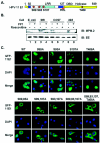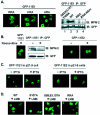Cyclin/CDK regulates the nucleocytoplasmic localization of the human papillomavirus E1 DNA helicase
- PMID: 15564503
- PMCID: PMC533924
- DOI: 10.1128/JVI.78.24.13954-13965.2004
Cyclin/CDK regulates the nucleocytoplasmic localization of the human papillomavirus E1 DNA helicase
Abstract
Cyclin-dependent kinases (CDKs) play key roles in eukaryotic DNA replication and cell cycle progression. Phosphorylation of components of the preinitiation complex activates replication and prevents reinitiation. One mechanism is mediated by nuclear export of critical proteins. Human papillomavirus (HPV) DNA replication requires cellular machinery in addition to the viral replicative DNA helicase E1 and origin recognition protein E2. E1 phosphorylation by cyclin/CDK is critical for efficient viral DNA replication. We now show that E1 is phosphorylated by CDKs in vivo and that phosphorylation regulates its nucleocytoplasmic localization. We identified a conserved regulatory region for localization which contains a dominant leucine-rich nuclear export sequence (NES), the previously defined cyclin binding motif, three serine residues that are CDK substrates, and a putative bipartite nuclear localization sequence. We show that E1 is exported from the nucleus by a CRM1-dependent mechanism unless the NES is inactivated by CDK phosphorylation. Replication activities of E1 phosphorylation site mutations are reduced and correlate inversely with their increased cytoplasmic localization. Nuclear localization and replication activities of most of these mutations are enhanced or restored by mutations in the NES. Collectively, our data demonstrate that CDK phosphorylation controls E1 nuclear localization to support viral DNA amplification. Thus, HPV adopts and adapts the cellular regulatory mechanism to complete its reproductive program.
Figures




Similar articles
-
Nucleocytoplasmic shuttling of bovine papillomavirus E1 helicase downregulates viral DNA replication in S phase.J Virol. 2007 Jan;81(1):384-94. doi: 10.1128/JVI.01170-06. Epub 2006 Oct 11. J Virol. 2007. PMID: 17035309 Free PMC article.
-
Mitogen-activated protein kinases activate the nuclear localization sequence of human papillomavirus type 11 E1 DNA helicase to promote efficient nuclear import.J Virol. 2007 May;81(10):5066-78. doi: 10.1128/JVI.02480-06. Epub 2007 Mar 7. J Virol. 2007. PMID: 17344281 Free PMC article.
-
Interaction between cyclin-dependent kinases and human papillomavirus replication-initiation protein E1 is required for efficient viral replication.Proc Natl Acad Sci U S A. 1999 Jan 19;96(2):382-7. doi: 10.1073/pnas.96.2.382. Proc Natl Acad Sci U S A. 1999. PMID: 9892642 Free PMC article.
-
The nucleocytoplasmic transport of viral proteins.Virol Sin. 2010 Apr;25(2):79-85. doi: 10.1007/s12250-010-3099-z. Epub 2010 Apr 9. Virol Sin. 2010. PMID: 20960304 Free PMC article. Review.
-
Regulated nucleocytoplasmic trafficking of viral gene products: a therapeutic target?Biochim Biophys Acta. 2008 Jan;1784(1):213-27. doi: 10.1016/j.bbapap.2007.08.021. Epub 2007 Aug 31. Biochim Biophys Acta. 2008. PMID: 17933596 Review.
Cited by
-
The papillomavirus E1 helicase activates a cellular DNA damage response in viral replication foci.J Virol. 2011 Sep;85(17):8981-95. doi: 10.1128/JVI.00541-11. Epub 2011 Jul 6. J Virol. 2011. PMID: 21734054 Free PMC article.
-
Synthetic lethal mutations in the cyclin A interface of human cytomegalovirus.PLoS Pathog. 2017 Jan 27;13(1):e1006193. doi: 10.1371/journal.ppat.1006193. eCollection 2017 Jan. PLoS Pathog. 2017. PMID: 28129404 Free PMC article.
-
Different modes of human papillomavirus DNA replication during maintenance.J Virol. 2006 May;80(9):4431-9. doi: 10.1128/JVI.80.9.4431-4439.2006. J Virol. 2006. PMID: 16611903 Free PMC article.
-
Phosphorylation of the human papillomavirus type 16 E1--E4 protein at T57 by ERK triggers a structural change that enhances keratin binding and protein stability.J Virol. 2009 Apr;83(8):3668-83. doi: 10.1128/JVI.02063-08. Epub 2009 Feb 11. J Virol. 2009. PMID: 19211765 Free PMC article.
-
Development of quantitative and high-throughput assays of polyomavirus and papillomavirus DNA replication.Virology. 2010 Mar 30;399(1):65-76. doi: 10.1016/j.virol.2009.12.026. Epub 2010 Jan 15. Virology. 2010. PMID: 20079917 Free PMC article.
References
-
- Abraham, R. T. 2001. Cell cycle checkpoint signaling through the ATM and ATR kinases. Genes Dev. 15:2177-2196. - PubMed
-
- Amin, A. A., S. Titolo, A. Pelletier, D. Fink, M. G. Cordingley, and J. Archambault. 2000. Identification of domains of the HPV11 E1 protein required for DNA replication in vitro. Virology 272:137-150. - PubMed
-
- Auster, A. S., and L. Joshua-Tor. 2004. The DNA-binding domain of human papillomavirus type 18 E1: crystal structure, dimerization, and DNA binding. J. Biol. Chem. 279:3733-3742. - PubMed
-
- Bell, S. P., and A. Dutta. 2002. DNA replication in eukaryotic cells. Annu. Rev. Biochem. 71:333-374. - PubMed
Publication types
MeSH terms
Substances
Grants and funding
LinkOut - more resources
Full Text Sources

